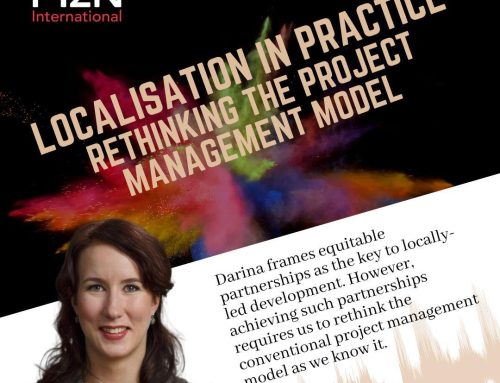At times lauded by technology enthusiasts, other times rejected by those sceptical of another ‘buzzword’ full of empty promises, innovation does not always meet consensus within organisations. But there is one thing everyone increasingly agrees upon: to fulfil the social impact sector’s raison d’etre and mission, we need to think outside the box to generate creative ideas and see past ‘same old’ solutions. But where do you start if you spend most of your time caught up in the day-to-day running of your organisation, juggling reporting deadlines or thinking about the next grant application? Many NGO leaders report not having the time and space to begin thinking about innovation.
Here we suggest a number of small, practical steps to unlock dormant drivers of creativity and stimulate fresh thinking in your organisation.
1. Break down silos and embrace a diversity of views and opinions
Attracting a diversity of talents, voices and lived experiences is not only a way for NGOs to walk their talk and look at bias within their organisations, it is also a key ingredient of innovative, thriving teams. Getting staff from the same departments and/or similar backgrounds used to working together, is likely to lead to groupthink, a killer of innovation. Yet organisations sometimes forget that they have access to board members and staff in finance, programmes or communication with very different takes on challenges and potential solutions.
Organisations sometimes forget that they have access to board members and staff in finance, programmes or communication with very different takes on challenges and potential solutions.
To bridge this gap, consider bringing everyone around the table for a rapid ideation session, promote hot-desking or encourage staff who don’t usually work together to bounce back ideas over a lunch or coffee. Actively reach out to contacts within your networks (and, why not, your supporters) with different skill sets and invite them to drop in to brainstorm around a challenge your organisation has been stuck on. In short, make small adjustments to promote better and more varied interactions.
2. Cultivate dissent (and psychological safety to do so…)
Innovation happens where there is a (healthy) element of friction. Getting a diverse group in the room is not enough if people do not feel comfortable challenging the status quo and long-held assumptions. For this to happen, we need spaces where staff feel respected and trust that expressing disagreement will not lead them to be dismissed as the ‘minority opinion’ but acknowledged for their valuable contribution.
Questioning is shown to encourage the quality of ideas and build common ground, from which everyone ultimately benefits. Small steps you can take in this direction include admitting and talking openly about failure (for example, a project that did not deliver or a fundraising drive that was not successful), showing humility, and letting go of a ‘control mentality’ which dictates that everything has to go according to a rigid plan. Sharing data and results transparently across the organisation will also likely stimulate criticism and constructive discussions.
3. Reframe the challenge
COVID-19 has taught us that the most adaptive NGOs have been able to turn one of the most challenging events of our times into an opportunity to do things differently: for example, negotiating more flexible funding with donors or accelerating their organisations’ digital transformation. We find that, oftentimes, leaders get stuck on a problem or overlook potential solutions simply because of the way the challenge has been looked at, or framed, in the first place. Practical, popular tools like using asking “How might we….” (… improve girls’ participation in our programmes / improve locally-led programme design / achieve better donor retention… and so on) can go a long way to stimulate the imagination. When tackling a challenge, also consider exploring fictional and alternative realities to uncover potential blind spots holding you back and get your creative juices flowing, for example by using this simple reframe tool.
The “HOW” opens up a realm of possibilities whilst keeping things grounded in action; “MIGHT” conveys the explorative nature of the inquiry; “WE” harnesses collective wisdom and collaboration.
4. Value empathy and connection
Designing new solutions that work and add value to the organisation requires us to deeply care about and connect with the people or cause we intend to serve as part of our mission. Because of the very nature of NGOs, we tend to take for granted that everyone shows up to work with commitment and passion, but, in doing so, we might overlook some important human stories and lose sight of one of the most powerful inner drivers of innovation: empathy. To unlock this, consider the following suggestions:
- make space for staff to express what motivates them,
- remind your team often of the big picture,
- make sure that strategic objectives are well-grounded in your vision and mission,
- and generally consider cutting the red tape creating bureaucracy and distance between the ‘real world’ and the back office of your organisation.
This might re-ignite some dormant inspiration, in turn driving innovation ‘from the inside out’.
5. Measure and celebrate small wins
We know that many leaders work on complex, intractable issues with no silver-bullet solution. And though innovation is not an end goal, it can be a means to bring you one step closer to solving these issues and fulfilling your mission. While not all experiments or new ideas will have a transformational impact, they can generate precious insights and encourage a culture of learning in your organisation.
While not all experiments or new ideas will have a transformational impact, they can generate precious insights and encourage a culture of learning in your organisation.
So make sure to track and capture the difference (in programme quality, money/time saved, etc.) innovation has enabled. This will be key to backing your argument and getting the buy-in of boards or colleagues when you see an idea or new way of working which should be scaled or embedded in your operations. Most importantly, this will ensure innovation does not just generate hype, but value, and is harnessed as one of many tools to help you achieve the social impact you have set out to deliver.





